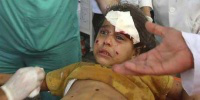Gaza: UN update on humanitarian situation

Injured child in Rafah hospital
Bullet-riddled facades, collapsed houses and buildings, roofs ripped. Gaza is a ravaged landscape. Few neighborhoods were spared from the fighting and bombings. The latest report from OCHA Office for the Coordination of Humanitarian Affairs of the United Nations, was issued on 25 August, the day before the cease-fire.
The report says that while on their side of the border, 70% of Israelis were at least able to leave their homes which were under constant rocket fire, Gazans had nowhere to flee. Many thousands of homes, hospitals, shops and trade have been destroyed. But it is more than just walls that need to be rebuilt. The feeling of constant fear, loss of relatives, atrocities seen or experienced, hard-lasting impressions. For psychosocial workers, the Palestinian Red Crescent, Caritas, CRS (Catholic Relief Services) and other humanitarian organisations, the priority is to deal with emergencies, the basic needs of civilians, food, water, shelter and help a population in shock tofind a sense of security and normalcy.
The intensity of the air strikes, the heavy fighting on the ground and the inability to flee the Gaza Strip generate a feeling of constant fear. A feeling reinforced by the fact that places once considered protected -theoritically, inviolable health centres and hospitals, schools, UN buildings - were sometimes directly targeted in retaliation for rockets fired from these places.
From July 7 (launch of the Border Protective operation) to August 25 (last report OCHA), on the Israeli side 67 Israelis were killed, including a four-year-old; on the Palestinian side, 2,076 Palestinians were killed, including 1,454 civilians, 491 children and 253 women.
In Gaza, more than 10,193 people were injured and more than 1,000 children will suffer lifelong disabilities. To these figures must be added about 25 Palestinians (exact figures have not been disclosed) accused of collaborating with Israel and killed by Hamas. A crime denounced by the Palestinian Fatah.
In this merciless war, more than 17,200 homes were destroyed or severely damaged, hundreds of them directly targeted by Israeli air strikes. As a result of the bombing, more than 475,0000 people have been displaced and 280,000 of them live in UNRWA schools, others in government shelters or live in foster homes or shelters.
No place is safe, people have nowhere to go since the blockade confines the population in the 400 square miles of the Gaza Strip, 44% of which has been designated by the Israeli army as a buffer zone.
The current military action in the Gaza Strip has devastated a population that was already experiencing a chronic humanitarian crisis before this recent action; 80% of the population received humanitarian assistance in the narrow sandy strip that has endured a blockade for seven years.
The UN has launched an emergency appeal for $367 million to meet immediate needs, including $293 million for food and shelter. Local and international organizations are mobilised.
Counting the loss
- The homes of at least 100,000 people were destroyed or severely damaged (17,200 households). The 100,000 people whose homes were destroyed or severely damaged need food aid. However, the entire population of Gaza has been affected by the conflict and almost all need food and other long-term aid.
- Electricity shortages limit the ability to store fresh produce for both shops and households.
Due to damage to farms and farmland, the price of some food products has increased, including fresh fruit, vegetables and eggs.
- More than 4,000 animals must be fed to prevent the loss of livelihoods. A high proportion of farmland was damaged, and livestock killed.
- Water and sanitation: at least 180,000 people have limited access to water. The lack of electricity and fuel also restrict water supply. The UN and other agencies are concerned about the risk of diseases related to lack of access to water. In fact, thousands of people live in overcrowded schools, shelters. This, coupled with the lack of water and poor sanitation, poses serious epidemic risks.
- Medical services and supplies: serious shortages of drugs and medical supplies hamper health benefits, particularly those related to emergencies, surgical procedures and intensive care units. The 29 hospitals working, manage with backup generators require fuel. 15 hospitals and 16 health centres damaged require reconstruction. The lack of specialized surgeons limits medical support to the injured.
- Psychological damage: At least 373,000 children need psychosocial support. Thousands of ERW (explosive remnants of war) are in built-up areas, posing a significant risk to children, farmers, aid workers and internally displaced people returning home.
- Education: The new school term, scheduled for 24 August, did not take place. The UN has announced a one-month period for the recovery, which could be extended if hostilities continue. 25 schools were destroyed or severely damaged, 230 were badly damaged. Nearly half a million children will not go back to school next week.
Source: OCHA report/Latin Patriarchate of Jerusalem


















